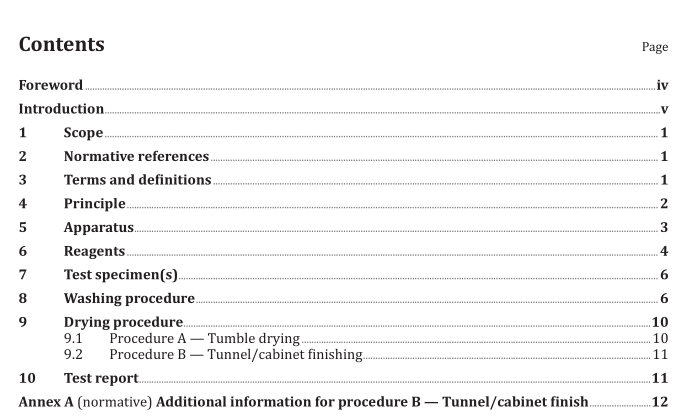ISO 15797 pdf download

ISO 15797 pdf download Textiles — Industrial washing and finishing procedures for testing of workwear
1 Scope
This document specifies test procedures and equipment which can be used in the evaluation ofworkwear (including,where appropriate,for some PPE garments) intended to be industriallylaundered. They serve as a basis for testing relevant properties such as dimensional stability, colourcharacteristics,creasing, seam puckering, pilling and visual aspects in general.
This document does not provide instructions and specifications for the procedures and equipment tobe used by industrial launderers.
As it is often not practical to reproduce industrial laundry processes (washing and drying/finishing) ina laboratory setting, this document provides an approach using defined intermediate scale equipmentand exacting test procedures which can be used for the evaluation of workwear intended to belaundered industrially.
As this document reflects a simulation of real-life industrial laundry conditions, in some cases, testingof the workwear in the actual industrial laundering equipment and processes intended to be used isadvisable when finally determining product and process compatibility.
lt is not necessary to test using all eight washing procedures nor both drying procedures. A selection ismade of the washing and drying procedure(s) that are best suited to the characteristics of the fabric orfabric composition and the intended use.
2Normative references
The following documents are referred to in the text in such a way that some or all of their contentconstitutes requirements of this document. For dated references, only the edition cited applies.Forundated references, the latest edition of the referenced document (including any amendments) applies.ISo 139, Textiles — Standard atmospheres for conditioning and testing
ISO 3071,Textiles —Determination of pH of aqueous extract
ISO 3759,Textiles — Preparation, marking and measuring of fabric specimens and garments in tests fordetermination of dimensional change
3Terms and definitions
For the purposes of this document, the following terms and definitions apply.
ISO and IEC maintain terminological databases for use in standardization at the following addresses:—IEC Electropedia: available at http://www.electropedia.org/
– ISo online browsing platform: available at https:.//www.iso.org/obp/3.1
cage
rotating container within which the load is held during the laundering processNote 1 to entry: The cage is generally fabricated from perforated stainless steel.
3.2
dead volume
volume of water left in the drum (3.4), such that the water surface lies at a tangent with the inside of the cage (3.1) in the stationary position
3.3
domestic laundering
washing/finishing of textiles according to size and volume needed by a single household
Note 1 to entry: The usual size of the cage (3.1) for domestic laundering is approximately 60 l.
3.4
drum
non-rotating container within which the cage (3.1) rotates
3.5
load ratio
ratio of the dry load to the net cage (3.1) volume
Note 1 to entry: The load ratio is expressed in kilogrammes per litre.
Note 2 to entry: Net cage volume is given by net volume of lifters, back wall and door.
3.6
g-factor
factor defined by the formula
where
n is the number of revolutions per minute (r/min);
d is the cage diameter in millimetres
3.7
industrial laundering
professional laundering of workwear (3.9) in greater quantities than domestic laundering (3.3)
3.8
liquor ratio
ratio of the dry load to the total amount of water
Note 1 to entry: The liquor ratio is expressed in kilogrammes per litre.
3.9
workwear
garment specifically designed to be worn in the workplace
Note 1 to entry: Its attributes are determined by the reason for its use, the activity in the workplace and the requirement to restore it for reuse.
4 Principle
The specimen (or relevant number of specimens) is washed in a washer/extractor and dried/finished according to one of the specified procedures. If multiple laundering cycles are required, each wash process shall be followed by drying/finishing.
5 Apparatus
5.1 Washer/extractor, with the following characteristics:
a) front- or side-loading open pocket horizontal rotating drum type;
b) cage volume: 220 l to 250 l;
c) diameter of cage: 750 mm to 850 mm;
d) depth of cage: 400 mm to 600 mm;
e) ratio (diameter of cage to depth of cage): 1,5 ± 15 %;
f) dead volume: 10 l to 20 l;









